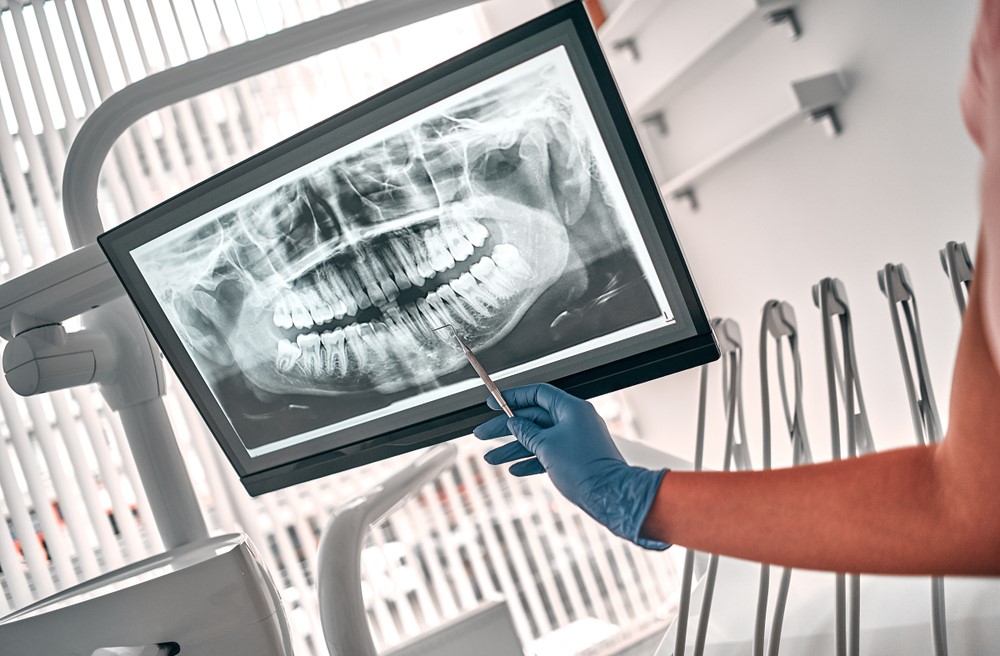Blog
Understanding Why You Need Dental X-Rays
March 10, 2022 / DENTISTRY

You already know about the importance of oral hygiene and keeping on top of your oral health. You also know that visits your family dentist in Caledon regularly is an important part of achieving and maintaining good oral health. If you’re seeing your dentist every 6-9 months as recommended, chances are you have spoken with them or their team about dental x-rays, and why they’re such an important part of your oral health plan.
Why do I need dental x-rays?
Dental x-rays help dentists see diseases and problems with teeth that cannot be recognized in a regular oral exam. They are an important tool used by dental professionals to help diagnose problems early on, before they develop into severe injuries or illnesses that require invasive treatment.
If you are experiencing dental pain, your dentist and hygienist will take x-rays to see what’s happening under the gumline and rule out any bone loss, cavities, cracks, fractures, abscesses, or other potential causes of discomfort. If you are not experiencing pain or discomfort and are not seen to be at risk of advanced decay, your oral healthcare team will still recommend having x-rays taken every 12-24 months to make sure that your tooth and bone structure are healthy. X-rays are also often taken as part of the planning process for restorative dental work, dental implants, or other cosmetic dentistry treatments.
What can I expect from a dental x-ray?
Dental x-rays are performed as part of your check-ups at your dental office in Caledon. There are multiple types of x-rays that your family dentist may perform. These include:
- Periapical x-rays, which offer a view of the whole tooth from the crown to the roots that keep it attached to the jawbone
- Bitewing x-rays, which show the upper and lower posterior teeth, and give a view of how the teeth touch one another
- Panoramic x-rays, which provide images of the teeth, jaws, nasal passages, sinuses, and the joints of the jaw, usually used in preparation for orthodontic work
- Occlusal x-rays, which provide images showing the floor of the mouth, often used to find extra teeth that are still hiding beneath the gumline
If it’s been a while since your last set of dental x-rays, call our team to set up an appointment. We’ll review your dental history and work with you to determine whether it’s time for you to have dental x-rays done.
Archive
- Managing Tooth Sensitivity: Causes and Solutions
- The Surprising Link Between Oral Health and Heart Disease
- Proper Care and Maintenance of Dental Implants
- Exploring Cosmetic Dentistry: Procedures and Benefits
- The Benefits of Invisalign for Straighter Teeth
- The Connection Between Gum Health and Overall Well-being
- Unmasking Tooth Sensitivity: Causes, Treatment, and Prevention
- Choosing the Right Toothbrush and Toothpaste for Your Family
- Crowns, Bridges, and Dentures: Caring for Your Dental Restorations
- Dental Woes Begone: Common Dental Problems and Their Solutions
- The Importance of Regular Dental Check-ups: What to Expect
- 5 Benefits Of Wearing a Mouthguard for Contact Sports
- Myths and Facts About the Use of Fluoride in Dentistry
- Dental Emergencies: What You Need to Know
- Three Tips for Maintaining the Best Oral Hygiene and Building a Healthy Smile that Lasts
- Why it’s Time to Consider Professional Tooth Whitening
- Dental X-Rays: When and How Often Do You Need Them?
- The Differences Between Store-Bought and Custom-Fit Mouthguards
- Dental Care for Seniors
- Everything You Need to Know About Tooth Extractions
- Everything You Need to Know About Cold Sores
- The Importance of Straight Teeth
- Understanding Why You Need Dental X-Rays
- Everything You Need to Know About Oral Healthcare for Seniors
- The Importance of Oral Health to You Overall Wellness
- Tooth Whitening at Home with Your Caledon Dentist
- Helping you Build a Bright, Confident Smile
- Helping you Build a Bright, Confident Smile
- Everything You Need to Know About Root Canals
- Should You Have Your Wisdom Teeth Removed?
- When Brushing Just Isn't an Option
- Restore Your Smile with Natural-Looking Inlays and Onlays
- Why Regular Dental Check-ups Are Important to Your Health



